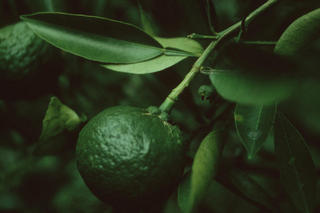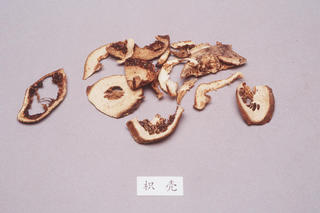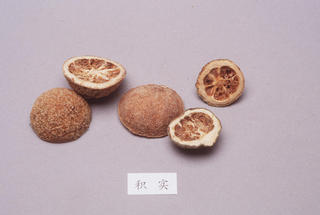Citrus aurantium
Contents
- 1 Nomenclature
- 2 Historical Use of Citrus aurantium
- 3 Background
- 4 Nomenclature
- 5 Historical Use of Citrus aurantium
- 6 Background
- 7 Nomenclature
- 8 Historical Use of Citrus aurantium
- 9 Background
- 10 Nomenclature
- 11 Historical Use of Citrus aurantium
- 12 Background
- 13 Pharmaceutical Information
- 14 Evidence or the Use of Citrus aurantium in the Treatment of Epilepesy
- 15 Safety
Nomenclature
Other Names:
Historical Use of Citrus aurantium
Citrus aurantium in Traditional Chinese Medicine
Background
Chinese Name (pinyin): Zhiqiao
Chinese Name :
Common Name :Orange Fruit
Specific Name : Fructus aurantii
Scientific Name:
Collection : The drug is collected in July when the fruit is green yet, Cut in the middle into two parts, dried in the sun or at low temperature.
Description : Semispheroidal, 3 - 5cm in diameter, exocarp dark brown or brown, with glandular convexes and sunken oil cavity spots at the apex, remains of style of the fruit stalk scar distinct, mesocarp in transverse section, yellowish white, smooth and slightly prominent, 0.4 - 1.3 cm thick, with 1 - 2 rows of oilk cavities at the outer part of the pericarp. Texture hard, uneasily broken, pulp vesicles 7 - 12 a few up to 15, juice vesicles dried and shrunken, brown to dark brown, containing seeds. Odour aromatic, taste bitter and slightly sour.
Identification : 1.Powder: Yellowish white or brownish yellow, cells of mesocarp subrounded or irregular, most cell walls unevenly thickened and beaded. Epidermal cells of pericarp polygonal, subsquare or rectangular in surface view. Stomata subrounded, 16 - 34µm in diameter, subsidiary cells 5 - 9, covered with cuticle in lateral view. Juice vesicle tissues pale yellow or colorless, membranous, epidermal cells narrow and long in surface view, shrunken , crisscross with cells of pericarp and vesicle, prisms of calcium oxalate, existing in the cells of pericarp and juice vesicle, abundant in cells adjacent to epidermis, rhombic, polygonal or biconical, 3 - 30µm in diameter, spiral and reiculated vessels and tracheids small.2.To 0.5g of the powder add 10ml of methanol, heat under reflux for 10 minutes, filter. To 1ml of the filtrate, add about 5mg of potassiun tetrahydroborate, mix well, add several drops of hydrochloric acid, a cherry red to purplish red colour is produced.Total ash: not more than 7.0%
Processing : Eliminate foreign matter, wash, soften thoroughly, cut into thin slices, sift out the broken pulp and seeds after drying.Stir fry with bran: Stir fry the slices as described under the method for stir frying with bran (Appendix ll D) until a deep color is produced.
Action : To regulate the flow of qi, remove its stagnation, and alleviate distension.
Indication : distension and pain in the chest and hypochondriac regions due to stagnation of qi; indigestion with retention of phlegm and fluid; gastroptosis, prolapse of the rectum, prolapse of the uterus
Precautions : Used with caution in pregnancy.
Dosage : 3 to 9 g.
Storage : Preserve in a cool and dry place, protected from mth.
Nomenclature
Other Names:
Historical Use of Citrus aurantium
Citrus aurantium in Traditional Chinese Medicine
Background
Chaozhishi ³´è×ʵ
Xiaozhishi Сè×ʵ
Chinese Name (pinyin): Zhishi
Chinese Name :
Common Name :Immature Bitter Orange
Specific Name : Fructus aurantii immaturus
Scientific Name:
Collection : The fallen fruit is collected in May and June, removed from foreign matter, cut transversely in the middle into two parts, dried in the sun or at low temperature. The small fruit dried similarly without cutting.
Description : Semispheroidal, few spheroidal, 0.5 - 2.5cm in diameter. Exocartp dark green or dark brownish green with glandular protrudings and wrinkles, remains of the style or fruit stalk scar distinct, mesocarp in transverse section slightly expanded, yellowish white or yellowish brown, 3.0 - 1.2cm thick with 1 - 2 rows of oil cavities on the outer part, endocarp and juice vesicles brown. Texture hard, odor aromatic, taste bitter and slightly sour.
Identification : 1.Powder: Pale yellow or brownish yellow. Cells of mesocarp subrounded or irregular, most cell walls unevenly thickened and beaded. Epidermal cells of pericarp polygonal, subsquare or rectangular in surface view, stomata subrounded, 18 - 26µm in diameter, subsidiary cells 5 - 9, covered with cuticle in lateral view. Prisms of calcium oxalate existing cells of pericarp and juice vesicles mostly visible in cells adjacent to epidermis, rhombic, polygonal or biconical, 2 - 24µm in diameter. Parenchymatous cells containing yellow or colorless hesperidin crystals in rounded or amorphous masses some with radial striations. Fragments of oil cavity abundant, secretory cells slender and curved. Spiral and reticulated vessels and tracheids small.2.Heat 0.5g of the powder with 10ml of methanol under reflux for 10 minutes and filter. To 1ml of the filtrate add about 5mg of potassium tetrahydroborate, mix well and add several drops of hydrochloric acid, a cherry red to purplish red colour is produced. 3.Heat 0.5g of the powder with 5ml of methanol under reflux for 1 hour. Allow to cool, filter, evaporate the filtrate to dryness. Dissolve the residue in 4ml of methanol and filtrate, use the filtrate as the test solution. Dissolve synephrine CRS in methanol to prepare solution containing 3mg per ml, use as the reference solution. Carry out the method for thin layer chromatography (Appendix Vl B), using silica gel H with sodium carboxymethylcellulose as the coating substance and methanol-acetone-chloroform-concentrated ammonia TS (3:4:13:0.5) as the mobile phase. Apply separately 10µl of each of the two solution to the plate, dry it in the air, spray with 0.5% solution of ninhydrin in ethanol and heat at 105ºC for about 10 minutes. The spot in the chromatogram obtained with the test solution correspond in p[osition and color to the spot in the chromatogram obtained with the reference solution.Total ash: not more than 7.0%
Processing : Immature Orange fruit, eliminate foreign matter, wash clean, soften thoroughly, cut into thin slices and dry.Stir fry with bran: stir fry the slices as describe under the method for stir frying with bran until deep color is produced.
Action : To eliminate stagnation of qi, resolve phlegm and relieve stuffiness sensation in the chest and abdomen.
Indication :
Precautions : Used with caution in pregnancy.
Dosage : 3 to 9 g.
Storage : Preserve in a cool and dry place, protected from moth.
Nomenclature
Other Names:
Historical Use of Citrus aurantium
Citrus aurantium in Traditional Chinese Medicine
Background
Chinese Name (pinyin): Zhiqiao
Chinese Name :
Common Name :Orange Fruit
Specific Name : Fructus aurantii
Scientific Name:
Collection : The drug is collected in July when the fruit is green yet, Cut in the middle into two parts, dried in the sun or at low temperature.
Description : Semispheroidal, 3 - 5cm in diameter, exocarp dark brown or brown, with glandular convexes and sunken oil cavity spots at the apex, remains of style of the fruit stalk scar distinct, mesocarp in transverse section, yellowish white, smooth and slightly prominent, 0.4 - 1.3 cm thick, with 1 - 2 rows of oilk cavities at the outer part of the pericarp. Texture hard, uneasily broken, pulp vesicles 7 - 12 a few up to 15, juice vesicles dried and shrunken, brown to dark brown, containing seeds. Odour aromatic, taste bitter and slightly sour.
Identification : 1.Powder: Yellowish white or brownish yellow, cells of mesocarp subrounded or irregular, most cell walls unevenly thickened and beaded. Epidermal cells of pericarp polygonal, subsquare or rectangular in surface view. Stomata subrounded, 16 - 34µm in diameter, subsidiary cells 5 - 9, covered with cuticle in lateral view. Juice vesicle tissues pale yellow or colorless, membranous, epidermal cells narrow and long in surface view, shrunken , crisscross with cells of pericarp and vesicle, prisms of calcium oxalate, existing in the cells of pericarp and juice vesicle, abundant in cells adjacent to epidermis, rhombic, polygonal or biconical, 3 - 30µm in diameter, spiral and reiculated vessels and tracheids small.2.To 0.5g of the powder add 10ml of methanol, heat under reflux for 10 minutes, filter. To 1ml of the filtrate, add about 5mg of potassiun tetrahydroborate, mix well, add several drops of hydrochloric acid, a cherry red to purplish red colour is produced.Total ash: not more than 7.0%
Processing : Eliminate foreign matter, wash, soften thoroughly, cut into thin slices, sift out the broken pulp and seeds after drying.Stir fry with bran: Stir fry the slices as described under the method for stir frying with bran (Appendix ll D) until a deep color is produced.
Action : To regulate the flow of qi, remove its stagnation, and alleviate distension.
Indication : distension and pain in the chest and hypochondriac regions due to stagnation of qi; indigestion with retention of phlegm and fluid; gastroptosis, prolapse of the rectum, prolapse of the uterus
Precautions : Used with caution in pregnancy.
Dosage : 3 to 9 g.
Storage : Preserve in a cool and dry place, protected from mth.
Nomenclature
Other Names:
Historical Use of Citrus aurantium
Citrus aurantium in Traditional Chinese Medicine
Background
Chaozhishi ³´è×ʵ
Xiaozhishi Сè×ʵ
Chinese Name (pinyin): Zhishi
Chinese Name :
Common Name :Immature Bitter Orange
Specific Name : Fructus aurantii immaturus
Scientific Name:
Collection : The fallen fruit is collected in May and June, removed from foreign matter, cut transversely in the middle into two parts, dried in the sun or at low temperature. The small fruit dried similarly without cutting.
Description : Semispheroidal, few spheroidal, 0.5 - 2.5cm in diameter. Exocartp dark green or dark brownish green with glandular protrudings and wrinkles, remains of the style or fruit stalk scar distinct, mesocarp in transverse section slightly expanded, yellowish white or yellowish brown, 3.0 - 1.2cm thick with 1 - 2 rows of oil cavities on the outer part, endocarp and juice vesicles brown. Texture hard, odor aromatic, taste bitter and slightly sour.
Identification : 1.Powder: Pale yellow or brownish yellow. Cells of mesocarp subrounded or irregular, most cell walls unevenly thickened and beaded. Epidermal cells of pericarp polygonal, subsquare or rectangular in surface view, stomata subrounded, 18 - 26µm in diameter, subsidiary cells 5 - 9, covered with cuticle in lateral view. Prisms of calcium oxalate existing cells of pericarp and juice vesicles mostly visible in cells adjacent to epidermis, rhombic, polygonal or biconical, 2 - 24µm in diameter. Parenchymatous cells containing yellow or colorless hesperidin crystals in rounded or amorphous masses some with radial striations. Fragments of oil cavity abundant, secretory cells slender and curved. Spiral and reticulated vessels and tracheids small.2.Heat 0.5g of the powder with 10ml of methanol under reflux for 10 minutes and filter. To 1ml of the filtrate add about 5mg of potassium tetrahydroborate, mix well and add several drops of hydrochloric acid, a cherry red to purplish red colour is produced. 3.Heat 0.5g of the powder with 5ml of methanol under reflux for 1 hour. Allow to cool, filter, evaporate the filtrate to dryness. Dissolve the residue in 4ml of methanol and filtrate, use the filtrate as the test solution. Dissolve synephrine CRS in methanol to prepare solution containing 3mg per ml, use as the reference solution. Carry out the method for thin layer chromatography (Appendix Vl B), using silica gel H with sodium carboxymethylcellulose as the coating substance and methanol-acetone-chloroform-concentrated ammonia TS (3:4:13:0.5) as the mobile phase. Apply separately 10µl of each of the two solution to the plate, dry it in the air, spray with 0.5% solution of ninhydrin in ethanol and heat at 105ºC for about 10 minutes. The spot in the chromatogram obtained with the test solution correspond in p[osition and color to the spot in the chromatogram obtained with the reference solution.Total ash: not more than 7.0%
Processing : Immature Orange fruit, eliminate foreign matter, wash clean, soften thoroughly, cut into thin slices and dry.Stir fry with bran: stir fry the slices as describe under the method for stir frying with bran until deep color is produced.
Action : To eliminate stagnation of qi, resolve phlegm and relieve stuffiness sensation in the chest and abdomen.
Indication :
Precautions : Used with caution in pregnancy.
Dosage : 3 to 9 g.
Storage : Preserve in a cool and dry place, protected from moth.
Synonymns for Citrus aurantium
Patent Medicines and Medicines with Multiple Ingredients that include Citrus aurantium
Pharmaceutical Information
Chemical Constituents
Evidence or the Use of Citrus aurantium in the Treatment of Epilepesy
Basic Science
Animal Studies
Cohort, Case-Control and Non-Randomized Trials
Randomized Controlled Trials
Meta-Analysis
1st Five Results: pubmed search
Wenqing He, Yunfei Huang, Shengquan Zhou, Joe M Regenstein, Lufeng Wang
A composite gel formed by konjac glucomannan together with Nano-CF obtained by FeCl3-citric acid hydrolysis as a potential fat substitute.
Int J Biol Macromol: 2024;131618
[PubMed:38631593]
[WorldCat.org]
[DOI]
(I a)
Yu-Xia Du, Jian-Mei Dong, Hang-Xiu Liu, Xiao-Men Fu, Jun Guo, Xin-Pu Lai, Hong-Ming Liu, Di Yang, Hong-Xia Yang, Xian-Yan Zhou, Jia-Mei Mao, Min Chen, Jin-Zhi Zhang, Jian-Qiang Yue, Jing Li
Transcription-related metabolic regulation in grafted lemon seedlings under magnesium deficiency stress.
Plant Physiol Biochem: 2024, 210;108615
[PubMed:38631158]
[WorldCat.org]
[DOI]
(I a)
Lingzhuo An, Guanglu Chang, Luyao Zhang, Pengwang Wang, Wenyuan Gao, Xia Li
Pectin: Health-promoting properties as a natural galectin-3 inhibitor.
Glycoconj J: 2024;
[PubMed:38630380]
[WorldCat.org]
[DOI]
(I a)
Lian-Hao Zhou, Quan-Chao Zeng, Tang-Ying-Ze Mei, Ming-Xia Wang, Wen-Feng Tan
[Intensive Citrus Cultivation Suppresses Soil Phosphorus Cycling Microbial Activity].
Huan Jing Ke Xue: 2024, 45(5);2881-2890
[PubMed:38629550]
[WorldCat.org]
[DOI]
(P p)
Jintao Lou, Fan Wu, Wuhui He, Rui Hu, Ziyi Cai, Guisheng Chen, Wenji Zhao, Zhigang Zhang, Yu Si
Hesperidin activates Nrf2 to protect cochlear hair cells from cisplatin-induced damage.
Redox Rep: 2024, 29(1);2341470
[PubMed:38629504]
[WorldCat.org]
[DOI]
(I p)


